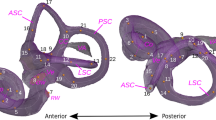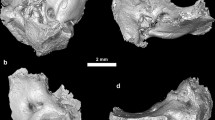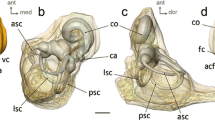Abstract
Interest in the phylogeny of Macroscelididae (sengis or elephant shrews) has been prompted by molecular studies indicating that Elephantulus rozeti is best placed as the sister group of Petrodromus tetradactylus (this clade being in turn the sister taxon to Macroscelides proboscideus) than among other species of the genus Elephantulus. Until now, no discrete morphological characters have been proposed to support the grouping of E. rozeti, Petrodromus, and Macroscelides into this single so-called ‘Panelephantulus’ clade. Here, we employed μCT scanning in order to investigate the petrosal and bony labyrinth (bony capsule of the inner ear) morphology of most species of extant Macroscelididae. We performed a cladistic analysis on ear traits and found that despite some convergences (e.g., concerning the bony arterial canals in Macroscelides and Rhynchocyon) the middle and inner ear morphology furnishes significant support for the ‘Panelephantulus’ clade. In our analysis, this clade is unambigously supported by the presence of a fully ossified stapediofacial tube. Two additional characters (the presence of a bony septum at the mouth of the fenestra cochleae dividing the D3 sinus into two distinct cavities and the absence of an accessory lateral pneumatic fossa) could also support ‘Panelephantulus.’ These newly discovered morphological characters support the molecular phylogenies published and highlight the importance of coding hitherto difficult to sample morphologies within cladistic analyses using micro-CT techniques. Taxonomic implications are briefly discussed.












Similar content being viewed by others
References
Asher RJ, Helgen KM (2010) Nomenclature and placental mammal phylogeny. BMC Evol Biol 10:102
Benoit J, Orliac M, Tabuce R (2012) The petrosal anatomy of Chambius, a primitive sengi (Macroscelidea, Afrotheria). Fundamental 20: 19-20A
Benoit J, Orliac M, Tabuce R (2013) The petrosal of Chambius (Macroscelidea, Afrotheria) from the Eocene of Djebel Chambi (Tunisia) and the evolution of the ear region in sengis. J Syst Palaeontol DOI:10.1080/14772019.2012.713400
Bloch JI, Silcox MT (2006) Cranial anatomy of the Paleocene plesiadapiform Carpolestes simpsoni (Mammalia, Primates) using ultra high-resolution X-ray computed tomography, and the relationships of plesiadapiforms to Euprimates. J Hum Evol 50: 1–35
Bremer K (1994) Branch support and tree stability. Cladistics 10: 295–304
Bugge J (1972) The cephalic arterial system in the insectivores and the primates with special reference to the Macroscelidoidea and Tupaioidea and the insectivore-primate boundary. Z Anat Entwicklungsgesch 135(3):279–300
Bugge J (1974) The cephalic arterial system in insectivores, primates, rodents and lagomorphs with special reference to the systematic classification. Acta Anat 87: 1–60
Butler PM (1969) Insectivores and bats from the Miocene of East Africa: new material. In: Leakey LSB (ed) Fossil Vertebrates of Africa, Vol 1. Academic Press, NewYork, pp 1–38
Corbet GB (1995) A cladistic look at classification within the subfamily Macroscelidinae based upon morphology. Mammal Rev 25: 15–17
Corbet GB, Hanks J (1968) A revision of the sengis, family Macroscelididae. Bull Br Mus Nat Hist Zool Ser 16: 47–111
Diamond MK (1989) Coarctation of the stapedial artery: an unusual adaptive response to competing functional demands in the middle ear of some eutherians. J Morphol 200(1): 71–86
Douady CJ, Catzeflis F, Raman J, Springer MS, Stanhope MJ (2003) The Sahara as a vicariant agent, and the role of Miocene climatic events, in the diversification of the mammalian order Macroscelidea (sengis). Proc Natl Acad Sci USA 100: 8325–8330
Ekdale EG (2009) Variation within the bony labyrinth of mammals. PhD dissertation, University of Texas
Evans FG (1942) The osteology and relationships of the elephant shrews (Macroscelididae). Bull Am Mus Nat Hist 80: 85–125
Findlay GH (1944) The development of the auditory ossicles in the elephant shrew, the tenrec and the golden mole. Proc Zool Soc Lond 114: 91–99
Fleischer G (1973) Studien am Skelett des Gehörorgans der Säugetiere, einschließlich des Menschen. Säugetierk Mitt 21: 131–239
Geisler JH, Luo Z (1996) The petrosal and inner ear of Herpetocetus sp. (Mammalia: Cetacea) and their implications for the phylogeny and hearing of archaic mysticetes. J Paleontol 70: 1045–1066
Heffner RS (2004) Primate hearing from a mammalian perspective. Anat Rec A 281A: 1111–1122
Holroyd PA (2010) Macroscelidea. In: Werdelin L, Sanders WJ (eds) Cenozoic Mammals of Africa. University of California Press, Berkeley, pp 89–98
Kuntner M, May-Collado LJ, Agnarsson I (2011) Phylogeny and conservation priorities of afrotherian mammals (Afrotheria, Mammalia). Zool Scripta 40: 1–15
MacPhee RDE (1981) Auditory regions of primates and eutherian insectivores: morphology, ontogeny, and character analysis. Contrib Primatol 18: 1–282
MacPhee RDE, Cartmill M (1986) Basicranial structures and primate systematics. In: Swindler DR, Erwin J (eds) Comparative Primate Biology, Vol. 1: Systematics, Evolution, and Anatomy. Alan R. Liss, New York, pp 219–275
Novacek M (1984) Evolutionary stasis in the sengi, Rhynchocyon. In: Eldredge N, Stanley SM (eds) Living Fossils. Springer, New York, pp 4–22
Novacek MJ (1986) The skull of leptictid insectivorans and the higher-level classification of eutherian mammals. Bull Am Mus Nat Hist 183: 1–111
Prothero DP (1993) Ungulate phylogeny: molecular vs. morphological evidence. In: Szalay FS, Novacek MJ, McKenna MC (ed) Mammal Phylogeny: Placentals. Springer, New York, pp 173–181
Rathbun GB (2009) Why is there discordant diversity in sengi (Mammalia: Afrotheria: Macroscelidea) taxonomy and ecology? Afr J Ecol 47: 1–13
Saban R (1957) Les affinités du genre Tupaia Raffles 1821, d’après les caractères morphologiques de la tête osseuse. Ann Paléontol 43: 1–44
Scalici M, Panchetti F (2011) Morphological cranial diversity contributes to phylogeny in soft-furred sengis (Afrotheria, Macroscelidea). Zoology 114 (2): 85–94
Segall W (1970) Morphological parallelisms of the bulla and auditory ossicles in some insectivores and marsupials. Fieldiana Zool 51: 169–205
Smit HA, Jansen van Vuuren B, O’Brien PCM, Ferguson-Smith M, Yang F, Robinson TJ (2011). Phylogenetic relationships of sengis (Afrotheria, Macroscelididae). J Zool 284: 133–143
Smit HA, Robinson TJ, Jansen Van Vuuren B (2007) Coalescence methods reveal the impact of vicariance on the spatial genetic structure of Elephantulus edwardii (Afrotheria, Macroscelidea). Mol Ecol 16: 2680–2692
Smit HA, Robinson TJ, Watson J, Jansen Van Vuuren B (2008) A new species of sengi (Afrotheria: Macroscelidea: Elephantulus) from South Africa. J Mammal 89: 1257–1268
Spoor F, Zonneveld F (1995). Morphometry of the primate bony labyrinth: a new method based on high resolution computed tomography. J Anat 186: 271–286
Swofford DL (2002) PAUP*. Phylogenetic Analysis Using Parsimony (and Other Methods). Version 4. Sinauer Associates, Sunderland, Massachusetts
Tabuce R, Asher RJ, Lehmann T (2008) Afrotherian mammals: a review of current data. Mammalia 72: 2–14
Tandler J (1899) Zur vergleichenden Anatomie der Kopfarterien bei den Mammalia. Denkschr Kais Akad Wissensch Wien Math-Naturwissenschaftl Klasse 67: 677–784
van der Klaauw CJ (1929) On the development of the tympanic region of the skull in the Macroscelididae. Proc Zool Soc Lond 99: 491–560
van der Klaauw CJ (1931) The auditory bulla in some fossil mammals. Bull Am Mus Nat Hist 62: 1–352
Wible JR (1986) Transformations in the extracranial course of the internal carotid artery in mammalian phylogeny. J Vertebr Paleontol 6: 313–325
Wible JR 1987. The eutherian stapedial artery: character analysis and implications for superordinal relationships. Zool J Linn Soc 91: 107–1350
Wible JR, Rougier GW, Novacek MJ, Asher RJ (2009) The eutherian mammal Maelestes gobiensis from the Late Cretaceous of Mongolia and the phylogeny of Cretaceous Eutheria. Bull Am Mus Nat Hist 327: 1–123
Acknowledgments
Thanks go to J. Cuisin, C. Bens, and T. Afoukati (Museum National d’Histoire Naturelle de Paris), P. Giere, F. Mayer, N. Lange, and O. Hampe (Museum für Naturkunde, Berlin), M. Lowe (University Museum of Zoology of Cambridge), and M. Nowak-Kemp (Oxford University Museum of Natural History), Y. Dutour, G. Cheylan, N. Vialle, and P. Michelier (Museum d’Histoire Naturelle d’Aix-en-Provence) for granting access to collections. We are grateful to A. Heaver (University of Cambridge), N. Karjilov and A. Hilger (Helmholtz-Zentrum, Berlin) for their help and advice during micro-CT scan acquisition and Montpellier Rio Imaging for providing access to their Skyscan 1076 Micro-CT machine. We are also grateful of R. Asher, L. Hautier, L. Marivaux, S. Benoit-Vrard, M. Vianey-Liaud, J.R. Wible, and an unknown reviewer whose advice improved this manuscript. This work has been conducted with the financial support of the ANR-08-JCJC-0017 (PALASIAFRICA) program. This is ISEM publication 201X-XXX.
Author information
Authors and Affiliations
Corresponding author
Rights and permissions
About this article
Cite this article
Benoit, J., Crumpton, N., Merigeaud, S. et al. Petrosal and Bony Labyrinth Morphology Supports Paraphyly of Elephantulus Within Macroscelididae (Mammalia, Afrotheria). J Mammal Evol 21, 173–193 (2014). https://doi.org/10.1007/s10914-013-9234-5
Published:
Issue Date:
DOI: https://doi.org/10.1007/s10914-013-9234-5




